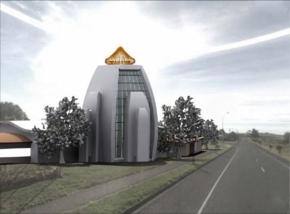Auckland student presents contemporary temple design

An Auckland architectural student has presented a design of a contemporary Hindu temple as a part of his final examination.
Unitec Master of Architecture student Bobby Banerjee’s unique final design presentation in Auckland, the culmination of two years’ research, has generated much interest.
About 25 people including Auckland temple committee members, academicians, students and architectural professionals attended the recent presentation which lasted about an hour.
Banerjee presented his proposal followed by a round of question and answer sessions not only from the judges but also from the public at large.
The design explores the traditional temple planning principles and interprets them in his contemporary design proposal. It is not a duplication of the traditional architectural forms as is usually done today but a synthesis of the sacred architectural elements used innovatively in New Zealand conditions.
“This study helped me assimilate the essential characteristics of a temple and its importance in imparting the feeling of sacredness in the mind of the worshipper,” Banerjee told the Indian Weekender.
“It helped me analyse the hierarchy of sacred space in the plan and its inter-dependence of the use of the traditional planning grid. Keeping these research parameters in mind helped me use their vocabulary and evolve my own language to express the inherent qualities of the temple in contemporary context in New Zealand.”
Banerjee’s final design of the temple is the formal sanctum and the worship area along a strict axis at an elevated level. Two huge skylights are inserted in the roof to accentuate this visual movement and enable the worshipper to be visually connected to the Shikhara even after entering the hall until one reaches the sanctum.
The marriage of a New Zealand vernacular and the formal Hindu temple becomes a strong design statement and a landmark in its own way.
Grant Watson, one of the committee members of ADNZ (Architectural Designers New Zealand), enjoyed the presentation and remarked: “It was fantastic. This must be presented to the architectural designers.”
A Hindu temple is designed as per the traditional planning principles with an element of acceptable variation in the overall design. The early temples in India have been documented by various scholars to understand the translation of these principles with respect to the final design.
Banerjee, who is also a director of Tarzan Design, said: “Over the years there seems to be a deviation from these principles, whereby the focus has been merely to produce an exterior skin with the imagery of a temple.
“The lack of correct understanding of the validity of these principles have resulted their being watered down or completely lost. However there has not been any notable research of the contemporary temples in India or abroad to substantiate or deny this point of view.
“This research investigated the use of the traditional planning principles for a Hindu temple, the local variants and its application to a new temple design in Auckland.
“The focus was to understand the importance of sacred spaces and compositional elements in the modern context.”
Banerjee said a temple was considered to be in harmony with the mathematical basis of the universe, provided it is constructed according to a mathematical system which determines the proportions of the design.
The worship pattern has changed over the years with changes in the lifestyle of the worshippers along with the introduction of electricity and new building materials. Some areas have been added while some traditional areas have been modified of shifted. Some of the outdoor activities have been accommodated indoors.
With a comparatively busier life than before, people visit temples either early morning, late evenings or during weekends. The pre-sunset activities conducted in the Temple earlier are now conducted in the evening to ensure people can participate in it after coming back from work.
It is observed that people today do not spend as much time in the Temple as they used to. They would prefer to go for a quick visit, offer their prayers and move on. Hence the Sanctum that was meant for personal worship earlier has now become part of a big hall where every assembled devotee can worship the Lord simultaneously.
As a result the dark small sanctum is now a part of a big hall with bright lights and a display of artwork or ornamental elements. The traditional hierarchy of space design has been maintained in most temples; however the spaces in themselves have undergone transformations.





Leave a Comment